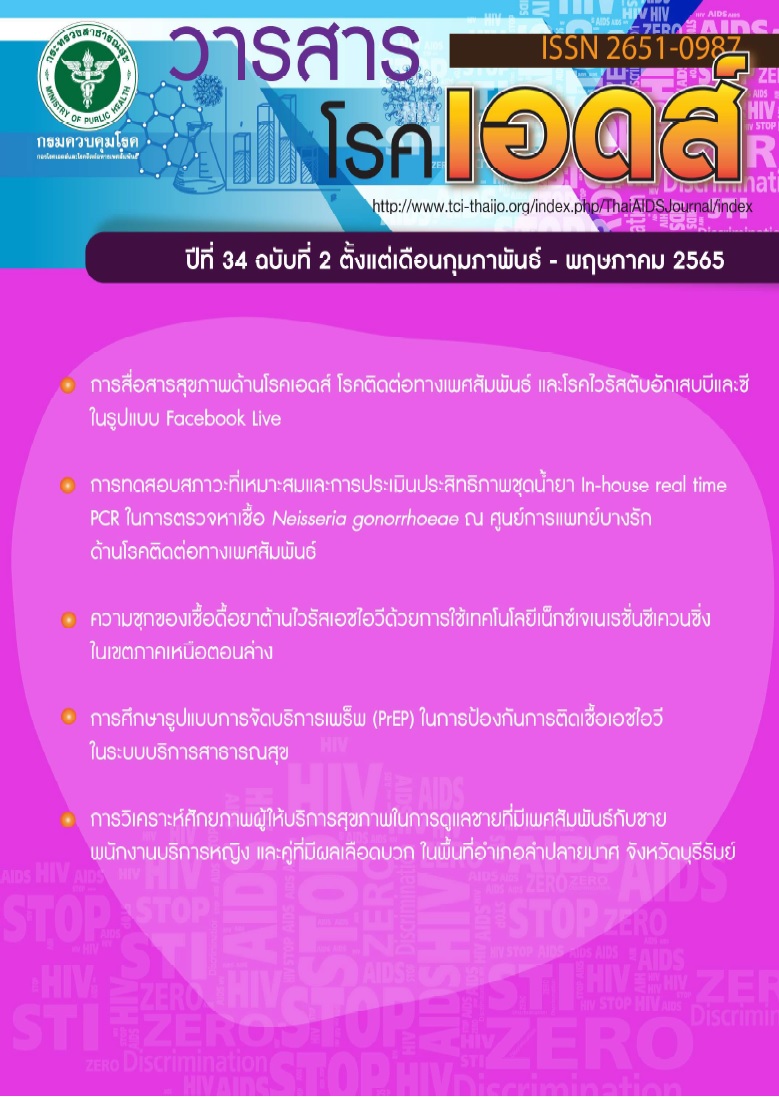ความชุกของเชื้อดื้อยาต้านไวรัสเอชไอวีด้วยการใช้เทคโนโลยีเน็กซ์เจเนเรชั่นซีเควนซิ่งในเขตภาคเหนือตอนล่าง
DOI:
https://doi.org/10.14456/taj.2022.8คำสำคัญ:
ความชุก, การดื้อยาต้านไวรัสเอชไอวี, เทคโนโลยีเน็กซ์เจเนเรชั่นบทคัดย่อ
การเฝ้าระวังเชื้อดื้อยาต้านไวรัสเอชไอวีในเขตภาคเหนือตอนล่าง ด้วยการตรวจหาจีโนทัยป์ของเชื้อดื้อต่อยาต้านไวรัสเอชไอวีโดยใช้เทคโนโลยีเน็กซ์เจเนเรชั่นซีเควนซิ่ง (Next generation Sequencing; NGS) ซึ่งยังไม่มีข้อมูลดังกล่าวมาก่อน เป็นการศึกษาแบบย้อนหลังเชิงพรรณนา ตั้งแต่เดือนมีนาคม 2561 ถึง กันยายน 2563 ในผู้ที่มีประวัติการรับประทานยาต้านไวรัสเอชไอวีสมํ่าเสมอและมีปริมาณไวรัสเอชไอวีมากกว่า 1,000 copies/ml จำนวน 614 ราย จากผู้ติดเชื้อเอชไอวีที่ได้รับการตรวจหาปริมาณไวรัสเอชไอวีทั้งหมด 13,461 ราย
พบผูที้่มีเชื้อดื้อยา 412 ราย มีความชุกของเชื้อดื้อยา ร้อยละ 3.06 ส่วนใหญ่เชื้อเป็นสายพันธุ์ CRF01_AE และปริมาณไวรัสเอชไอวีอยู่ระหว่าง 10,001-100,000 copies/ml ส่วนมากเชื้อดื้อต่อยา NRTIs ร่วมกับ NNRTIs 256 ราย กลุ่มยา NRTIs พบตำแหน่งที่เกี่ยวข้องการดื้อยา M184 มากที่สุดและยังพบตำแหน่ง K65 และ D67 ส่วนกลุ่มยา NNRTs, PIs, INSTIs ตำแหน่งที่พบมาก คือ K103, I54, A128 ตามลำดับ มี 1 รายที่มีเชื้อดื้อต่อทุกกลุ่มยา
การใช้เทคโนโลยี NGS จะเป็นเครื่องมือที่ช่วติดตามผลการรักษาด้วยยาต้านไวรัสเอชไอวี และช่วยให้ข้อมูลเพื่อทำแผนปฏิบัติการให้บรรลุตามยุทธศาสตร์แห่งชาติ
Downloads
เอกสารอ้างอิง
Fact Sheet UNAIDS [Internet] Global HIV & AIDS statistics [cited 2021 Aug 27]. Available from: https://www.unaids.org/en/resources/fact-sheet.
HIV INFO HUB. Estimated HIV infections, Thailand [Internet]. Nonthaburi: Division of AIDS and STIs, Department of Disease Control; 2021. [cited 2021 May 17]. Available form: https://hivhub.ddc.moph.go.th/epidemic.php. (in Thai)
NAP web report [Internet]. Nonthaburi: National Health Security Offices; c2016 [updated 2020 Dec 15; cited 2021 May 17]. Available form: http://napdl.nhso.go.th/NAPWebReport/(in Thai)
Philip L. Tzou, Pramila Ariyaratne, Vici Varghese, Charlie Lee, Elian Rakhmanaliev, Carolin Villy, Meiqi Yee, et al. Comparison of an In vitro diagnostic next generation sequencing for HIV-1 genotypic resistance testing. Journal of Clinical Microbiology. 2018; 56(6): e00105-18. https://doi.org/10.1128/JCM. 00105-18.
Shiven B Chabria, Shaili Gupta, Michael J Kozal. Deep sequencing of HIV: clinical and research applications. Annual Review of Genomics and Human Genetics. 2014; 15: 295-325. doi: 10.1146/annurev-genom-091212-153406. Epub 2014 May 9.
Surapol Kohreanudom. Surveillance of HIV-1 Antiretroviral Drug Resistant Strains in Thailand. Disease Control Journal. 2009; 35(1): 23-30. (in Thai)
Nareenart Iemwimangsa, Ekawat Pasomsub, Chonlaphat Sukasem, Wasun Chantratita. Surveillance of HIV-1 drug-resistance mutation in Thailand from 1999 to 2014. Southeast Asian J Trop Med Public Health. 2017; 48(2): 271-81.
Blood Transfusion Operation, Department of Medical Sciences.List of license to manufacture-import HIV test kits for sale in Thailand [Internet]. Nonthaburi: Department of Medical Sciences; 2021. [updated 2021 Aug 17; cited 2021 Dec 17]. Available from: http://ttp.dmsc.moph.go.th/ttp/th/file/file2download/2564/kit/TestKitUpdateAug21.pdf (in Thai)
Somsak Sintu-urai. The incidence of antiretroviral resistance and the prevalence of HIV mutations. Journal of Disease Prevention and Control: DPC.2 Phitsanulok. 2013; 1(2): 66-74. (in Thai)
Vela Diagnostics. Sentosa® SQ HIV-1 Genotyping Reagents. 2018.
World Health Organization. HIV Drug Resistance Report 2019. [cited 2021 Sep 3]. Available from: https://www.who.int/publications/i/item/WHO-CDS-HIV-19.21
Jariya Phadungpattanodom. The situation of HIV-1 antiretroviral drugs resistance in Pranangklao Hospital. Journal of Medical and Public Health Region 4. 2020; 10(2): 48-57. (in Thai)
Pornpimon Nimitsantiwong, Chorthip Wathitphan, Sukanta Kaveepatharanon, Kanoknun Thanomphakorn, Wasun Chantratita, Ekawat Pasomsub. Comparison of Sentosa SQ Deep Sequencing-Based HIV-1 Genotyping Coupled to Integrated Workflow with Sanger Sequencing Method for Detection of Drug Resistance Mutation. Southeast Asian J Trop Med Public Health. 2018; 49(2): 256-65.
Piyanot Wiratsilp, Ruangpung Sutthan, Chanthapong Wasi. New circulating Recombinant Forms of HIV-1 in Thailand. Thai Journal of Hematology and Transfusion Medicine. 2007; 17(2): 169-179. (in Thai)
Delgado E, Fernández García A, Pérez Losada M, Moreno Lorenzo M, Fernández Miranda I, Benito S. et al. Identifcation of CRF89_BF, a new member of an HIV 1 circulating BF intersubtype recombinant form family widely spread in South America. Scientific Reports. 2021; 11: 11442.
Bureau of AIDS, TB and STIs. Thailand National Guidelines on HIV/AIDS Diagnosis, Treatment and Prevention 2020/2021. 1st edition. Nonthaburi: Graphic and Design Alphabet Publishing Co., Ltd. (TH); 2020. (in Thai)
Peerayot Pamornsilpatham, Khumkwan Pamornsilpatham, Worawit Tangwilai. Limitation of Anti-HIV Drugs and New Drug Development. Thai Journal of Hospital Phamacy. 2009; 19(3): 247-58. (in Thai)
Annemarie M. Wensing, Vincent Calvez, Francesca Ceccherini-Silberstein, Charlotte Charpentier, Huldrych F. Günthard, Roger Paredes, et al. 2019 update of the drug resistance Mutations in HIV-1. Top Antivir Med. 2019; 27(3): 1-10.
Yuncong Wang, Hui Xing, Lingjie Liao, Zhe Wang, Bin Su, Quanbi Zhao, et al. The development of drug resistance mutations K103N Y181C and G190A in long term Nevirapine-containing antiviral therapy. AIDS Research and Therapy. 2014; 11(36): 1-9.
Joel E Gallant. The M184V mutation: what it does, how to prevent it, and what to do with it when it’s there. AIDS Read. 2006; 16(10):556-9.
Miller MD. K65R, TAMs and tenofovir. AIDS Rev. 2004; 6(1): 22-3.
Damian J McColl, Colombe Chappey, Neil T Parkin, Michael D Miller. Prevalence, genotypic associations and phenotypic characterization of K65R, L74V and other HIV-1 RT resistance mutations in a commercial database. Antivir Ther. 2008; 13(2): 189-97.
Sungkanuparph S, Manosuthi W, Kiertiburanakul S,Piyavong B, Chumpathat N, Chantratita W. Options for a Second-Line Antiretroviral Regimen for HIV Type 1-Infected Patients Whose Initial Regimen of a Fixed-Dose Combination of Stavudine, Lamivudine, and Nevirapine Fails. Clin Infect Dis. 2007; 44(3): 447-52.
Clutter DS, Jordan MR, Bertagnolio S, Shafer RW. HIV-1 Drug Resistance and Resistance Testing. Infect Genet Evol. 2016; 46: 292-307.
Tang MW, Shafer RW. HIV-1 antiretroviral resistance scientific principles and clinical applications. Drug. 2012; 2(9): e1-e25.
Tsai HC, Chen IT, Wu KS, Tseng YT, Sy CL, Chen JK. High rate of HIV-1 drug resistance in treatment failure patients in Taiwan, 2009-2014. Infection and Drug Resistance. 2017; 10: 343-52.
Kaitlin Anstett, Bluma Brenner, Thibault Mesplede, Mark A Wainberg. HIV drug resistance against strand transfer integrase inhibitors. Retrovirology. 2017; 14(36): 1-16.
Hung-Chin Tsai, I-Tzu Chen, Kuo-Wang Tsai, Susan Shin-Jung Lee, Yao-Shen Chen. Prevalence of HIV-1 Integrase Strand Transfer Inhibitor Resistance in Treatment-Naïve Voluntary Counselling and Testing Clients by Population Sequencing and Illumina Next-Generation Sequencing in Taiwan. Infection and Drug Resistance. 2020; 13: 4519-29.
Maria C Puertas, George Ploumidis, Michalis Ploumidis, Emilio Fumero, Bonaventura Clotet, Charles M Walworth, et al. Pan-resistant HIV-1 emergence in the era of integrase strand-transfer inhibitors: a case report. Lancet Microbe. 2020; 1: e130-35.



